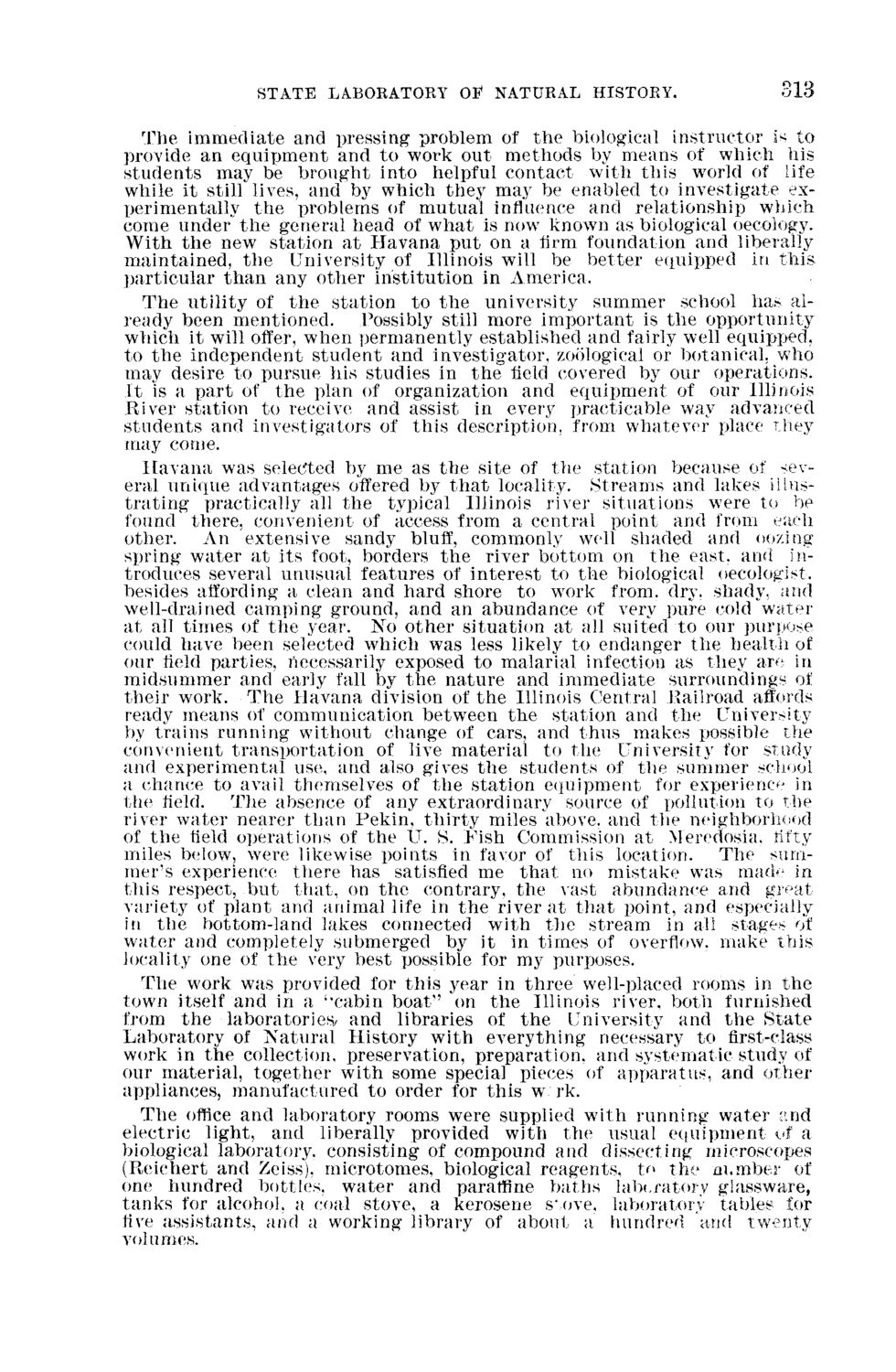| |
| |
Caption: Board of Trustees Minutes - 1894
This is a reduced-resolution page image for fast online browsing.

EXTRACTED TEXT FROM PAGE:
STATE LABORATORY OF NATURAL HISTORY. 313 The immediate and pressing problem of the biological instructor Is to provide an equipment and to work out methods by means of which his students may be brought into helpful contact with this world of life while it still lives, and by which they may be enabled to investigate experimentally the problems of mutual influence and relationship which come under^the general head of what is now known as biological oecology. With the new station at Havana put on a firm foundation and liberally maintained, the University of Illinois will be better equipped in this particular than any other institution in America. The utility of the station to the university summer school has already been mentioned. Possibly still more important is the opportunity which it will offer, when permanently established and fairly well equipped, to the independent student and investigator, zoological or botanical, who may desire to pursue his studies in the field covered by our operations. I t is a part of the plan of organization and equipment of our Illinois River station to receive and assist in every practicable way advanced students and investigators of this description, from whatever place they may come. Havana was selected by me as the site of the station because of several unique advantages offered by t h a t locality. Streams and lakes illustrating practically all the typical Illinois river situations were to be found there, convenient of access from a central point and from each other. An extensive sandy bluff, commonly well shaded and oozing spring water at its foot, borders the river bottom on the east, and introduces several unusual features of interest to the biological oecologist. besides affording a clean and hard shore to work from, dry. shady, and well-drained camping ground, and an abundance of very pure cold "water at all times of the year. No other situation at all suited to our purpose could have been selected which was less likely to endanger the health of our field parties, necessarily exposed to malarial infection as they are in midsummer and early fall by the nature and immediate surroundings of their work. The Havana division of the Illinois Central Railroad affords ready means of communication between the station and the University by trains running without change of cars, and thus makes possible the convenient transportation of live material to the University for study and experimental use, and also gives the students of the summer school a chance to avail themselves of the station equipment for experience in the field. The absence of any extraordinary source of pollution to the river water nearer than Pekin, thirty miles above, and the neighborhood of the field operations of the U. S. Fish Commission at Meredosia, fifty miles below, were likewise points in favor of this location. The summer's experience there has satisfied me t h a t no mistake was made in this respect, but that, on the contrary, the vast abundance and great variety of plant and animal life in the river at t h a t point, and especially iu the bottom-land lakes connected with the stream in all stages of water and completely submerged by it in times of overflow, make this locality one of the very best possible for my purposes. The work was provided for this year in three well-placed rooms in the town itself and in a ''cabin boat" on the Illinois river, both furnished from the laboratories/ and libraries of the University and the State Laboratory of Natural History with everything necessary to first-class work in the collection, preservation, preparation, and systematic study of our material, together with some special pieces of apparatus, and other appliances, manufactured to order for this w rk. The office and laboratory rooms were supplied with running water and electric light, and liberally provided with the usual equipment of a biological laboratory, consisting of compound and dissecting microscopes (Reiehert and Zeiss), microtomes, biological reagents, to the number of one hundred bottles, water and paraffine baths laboratory glassware, tanks for alcohol, a coal stove, a kerosene stove, laboratory tables for five assistants, and a working library of about a hundred and twenty volumes.
| |